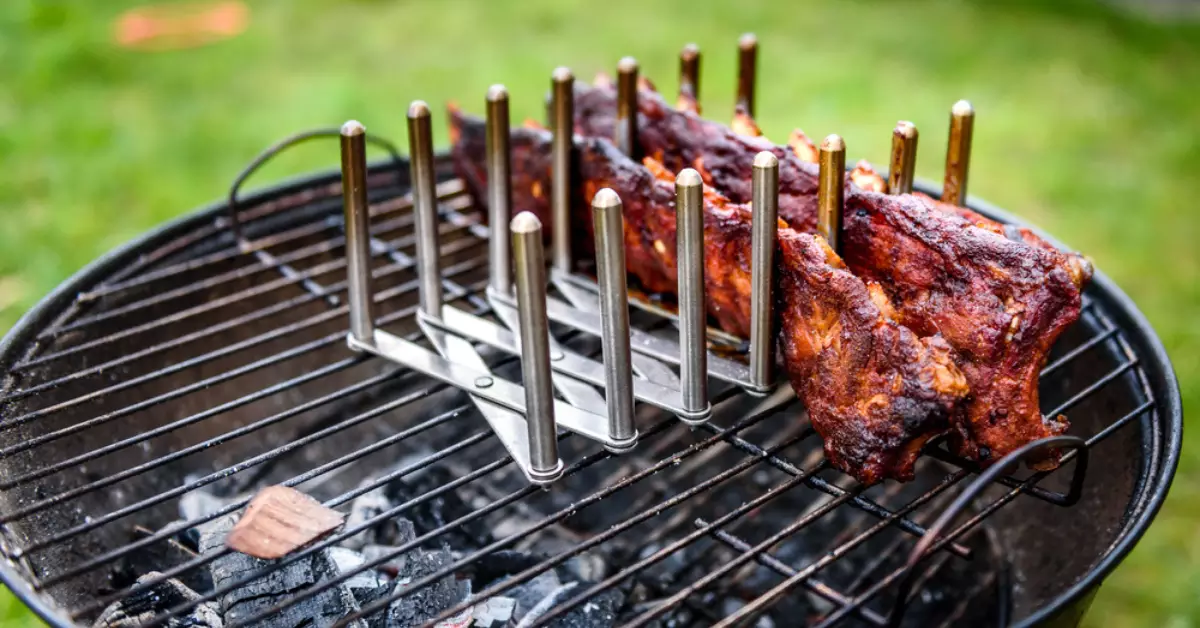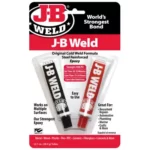Grilling enthusiasts and professional chefs alike constantly seek ways to maximize their culinary potential. One tool gaining popularity for its functionality and efficiency is the rib rack. A simple yet ingenious device, rib racks are designed to optimize grilling space and improve cooking results.
Simply put, rib racks allow you to vertically arrange ribs, enhancing space utilization, and promoting even cooking. This leads to consistently well-cooked ribs, achieving that perfect balance between tenderness and the much-desired barbecue crust.
In terms of worth, one can evaluate rib racks from various angles, such as efficiency, quality of cooking, user experiences, and cost-effectiveness. But like any culinary tool, its value is largely subjective, hinging on the user’s specific needs and grilling practices.
The Value of Rib Racks
Enhancing Cooking Efficiency
One of the main selling points of rib racks is their ability to improve cooking efficiency. By holding the ribs vertically, they allow for the strategic placement of multiple rib slabs on the grill simultaneously. This is particularly useful when entertaining a large crowd or preparing a hefty meal.
Maximizing Space on the Grill
Space optimization is another standout feature of rib racks. Standard grilling surfaces can quickly become crowded, limiting the amount of food you can prepare at once. Rib racks effectively double or even triple your grilling capacity, enabling you to make the most out of your grilling sessions.
Rib Racks and Meat Quality
Grilling is a culinary art, and like any art form, achieving the perfect balance of flavors and textures is pivotal. Two significant factors that impact the meat’s quality when grilling ribs are heat distribution and airflow. Rib racks can significantly influence these factors, thereby playing a crucial role in the final product’s quality.
Even Heat Distribution and Its Impact on Rib Quality
When grilling ribs, the heat’s uniform distribution is of prime importance. If ribs are placed flat on the grill, they are susceptible to uneven heat exposure. This could result in parts of the ribs being overcooked, dry, and tough, while other sections might remain undercooked, leading to a sub-optimal eating experience.
On the contrary, using a rib rack positions the ribs vertically, allowing for better heat circulation and ensuring that all sections of the ribs receive a uniform amount of heat. This promotes even cooking and tends to result in ribs that are uniformly tender and juicy, with the desirable barbecue crust.
Moreover, when cooking multiple racks of ribs, the ribs placed in the center, when laid flat, might receive less heat than those on the periphery. This leads to inconsistent cooking results. A rib rack eliminates this issue by providing each rib slab its own space, thereby promoting even heat distribution.
Importance of Airflow Around Ribs
Airflow is another critical factor that influences the quality of grilled ribs. When ribs are placed flat on the grill, the contact between the meat and the grill surface can limit airflow, affecting the cooking process.
With rib racks, ribs are positioned vertically, and there is ample space between each slab. This arrangement promotes sufficient airflow around the ribs, which is crucial for a few reasons:
- Crispy Crust Formation: Sufficient airflow aids in the formation of a crispy crust on the ribs – a characteristic that is often sought after in barbecued ribs. It helps to dry out the surface of the ribs, making them more conducive to browning and the formation of the crust.
- Smoke Penetration: In the case of smoking ribs, proper airflow allows for better smoke penetration, imparting a deeper and more complex flavor profile to the ribs.
- Prevents Soggy Ribs: Good airflow prevents the ribs from turning soggy, which can happen if they are crowded together, and the steam generated during cooking doesn’t have enough space to escape.
Rib Racks: A Comparative Analysis
Every tool in the culinary world has its unique pros and cons, and rib racks are no different. To truly understand if rib racks are worth it, one must compare them against traditional rib grilling methods, considering their advantages and disadvantages.
Rib Racks vs Traditional Barbecuing Methods
Traditional methods of grilling ribs involve laying them flat on the grill. While this method has been used for ages and can yield delicious results, it does have its limitations. These limitations are addressed by the use of rib racks, but using rib racks also presents its own set of challenges. Let’s delve into the pros and cons:
- Space Utilization: Traditional grilling methods limit the number of ribs that can be cooked simultaneously due to the lack of vertical space utilization. Rib racks solve this problem by allowing you to stack ribs vertically, thereby significantly enhancing the grill’s capacity.
- Even Cooking: As discussed above, when ribs are laid flat, they are prone to uneven heat exposure. With rib racks, the heat distribution is more even, yielding consistently cooked ribs.
- Ease of Turning: Turning multiple racks of ribs when they are laid flat can be a cumbersome task. Rib racks simplify this task as all you need to do is turn the entire rack.
However, using rib racks may not be ideal in certain situations:
- Smoking Ribs: For smoking ribs, some chefs prefer laying them flat as it exposes more surface area to the smoke, leading to a richer flavor.
- Basting and Saucing: Applying sauce or baste is easier when ribs are laid flat on the grill.
Pros and Cons of Rib Racks
Now that we have compared rib racks with traditional grilling methods, let’s evaluate their specific pros and cons:
Pros:
- Increased Capacity: Rib racks greatly increase the grill’s capacity, allowing for larger batches of ribs to be cooked simultaneously.
- Even Cooking: Rib racks promote even heat distribution, leading to uniformly cooked ribs.
- Easy Turning: Turning the ribs is simplified as you only need to turn the entire rack.
Cons:
- Cleaning: Cleaning rib racks can be labor-intensive as the sauce and drippings from the ribs can get stuck in the crevices.
- Storage: Storing large rib racks can pose a challenge, especially in kitchens where space is a constraint.
- Initial Investment: Rib racks come at an additional cost, and for occasional grillers, the investment may not justify the benefits.
Rib Racks: User Experiences
Real-life Examples of Rib Rack Usage
Many grillers swear by the effectiveness of rib racks. For instance, BBQ contest participants often use them to manage large quantities of ribs. Likewise, those hosting big backyard barbecues have found rib racks indispensable for serving all their guests at once.
Consumer Feedback and Ratings
Generally, consumer feedback and ratings for rib racks are positive. Users particularly commend the enhanced capacity and consistent cooking results. However, cleaning and storage issues have been noted in some reviews.
Selecting the Right Rib Rack: What to Look For
Choosing a rib rack that meets your specific requirements can significantly enhance your grilling experience. Here are a few factors to consider when investing in a rib rack:
Material and Durability
The material of the rib rack is a significant determinant of its durability and performance. Stainless steel rib racks are often preferred due to their longevity, resistance to rust, and easy maintenance.
However, cast iron racks are also available and can retain heat better, assisting in the cooking process. Always choose a rib rack made of high-quality, food-grade material that can withstand high temperatures and repeated use.
Capacity
The capacity of the rib rack is another crucial factor. Determine the number of rib slabs you typically cook simultaneously and select a rib rack that can accommodate your needs. Some racks can hold up to six slabs of ribs, making them suitable for large gatherings or commercial use.
Design
The design of the rib rack can influence the ease of use. Look for a rib rack that has an ergonomic design, providing stability and ensuring the ribs are held securely. Some racks come with handles, making them easier to move and turn on the grill.
Versatility
Some rib racks are versatile and can be used for grilling other types of meat, such as chicken or turkey, or even vegetables. If you grill a variety of foods, opting for a versatile rack can be a cost-effective choice.
Making the Most of Your Rib Rack
Best Practices for Using Rib Racks
- Preheat your grill before placing the rib rack
- Apply a dry rub or marinade to the ribs for enhanced flavor
- Monitor cooking times to prevent overcooking
Essential Rib Rack Accessories
- A good quality grilling thermometer to ensure correct cooking temperatures
- Long-handled tongs for safe and easy handling of ribs
Frequently Asked Questions
How do I clean a rib rack?
Most rib racks are dishwasher safe. However, for stubborn stains, soak the rack in warm soapy water and scrub it with a non-abrasive brush.
Can I use a rib rack for other types of meat?
Yes, you can. Rib racks are versatile and can hold various cuts of meat, such as beef short ribs, pork loin chops, and even certain types of poultry.
How long should I cook ribs on a rib rack?
The cooking time varies depending on the grill’s heat and the type of ribs. However, generally, ribs take about 1.5 to 2.5 hours to cook on a rib rack.
Conclusion
The debate on whether rib racks are worth it ultimately boils down to individual needs and preferences. They undeniably enhance grilling efficiency and facilitate even cooking, making them a valuable tool for many.
However, they are not without their drawbacks. Cleaning and storage challenges can deter some users, and the initial investment may not justify occasional use.
As a grilling enthusiast, assessing the advantages against the drawbacks will help you make an informed decision. Remember, the ultimate goal is to elevate your grilling experience and enjoy perfectly cooked ribs every time.







